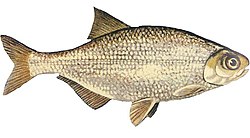| Bronze featherback | |
|---|---|
 | |
| Scientific classification | |
| Domain: | Eukaryota |
| Kingdom: | Animalia |
| Phylum: | Chordata |
| Class: | Actinopterygii |
| Order: | Osteoglossiformes |
| Family: | Notopteridae |
| Genus: | Notopterus Lacépède, 1800 |
| Species: | N. notopterus |
| Binomial name | |
| Notopterus notopterus (Pallas, 1769) | |
 | |
| Red:extant , Green: introduced | |
| Synonyms | |
| |
The bronze featherback (Notopterus notopterus) is a ray-finned fish in the family Notopteridae found in South and Southeast Asia. Although primarily found in fresh water, it has been known to enter brackish water. [2] At present, it is the only member of the genus Notopterus, [3] but as currently defined, it is likely a species complex. [1]






